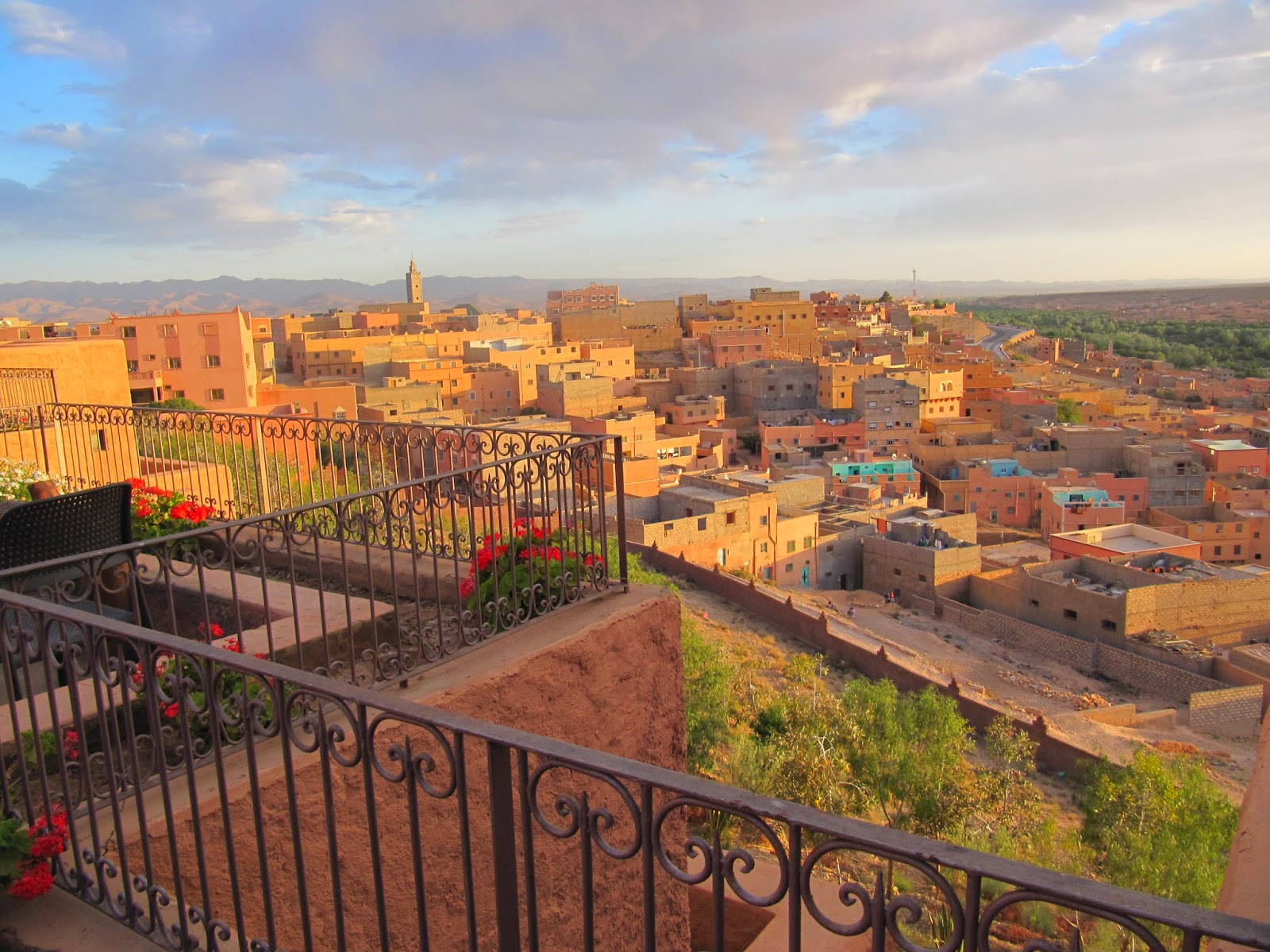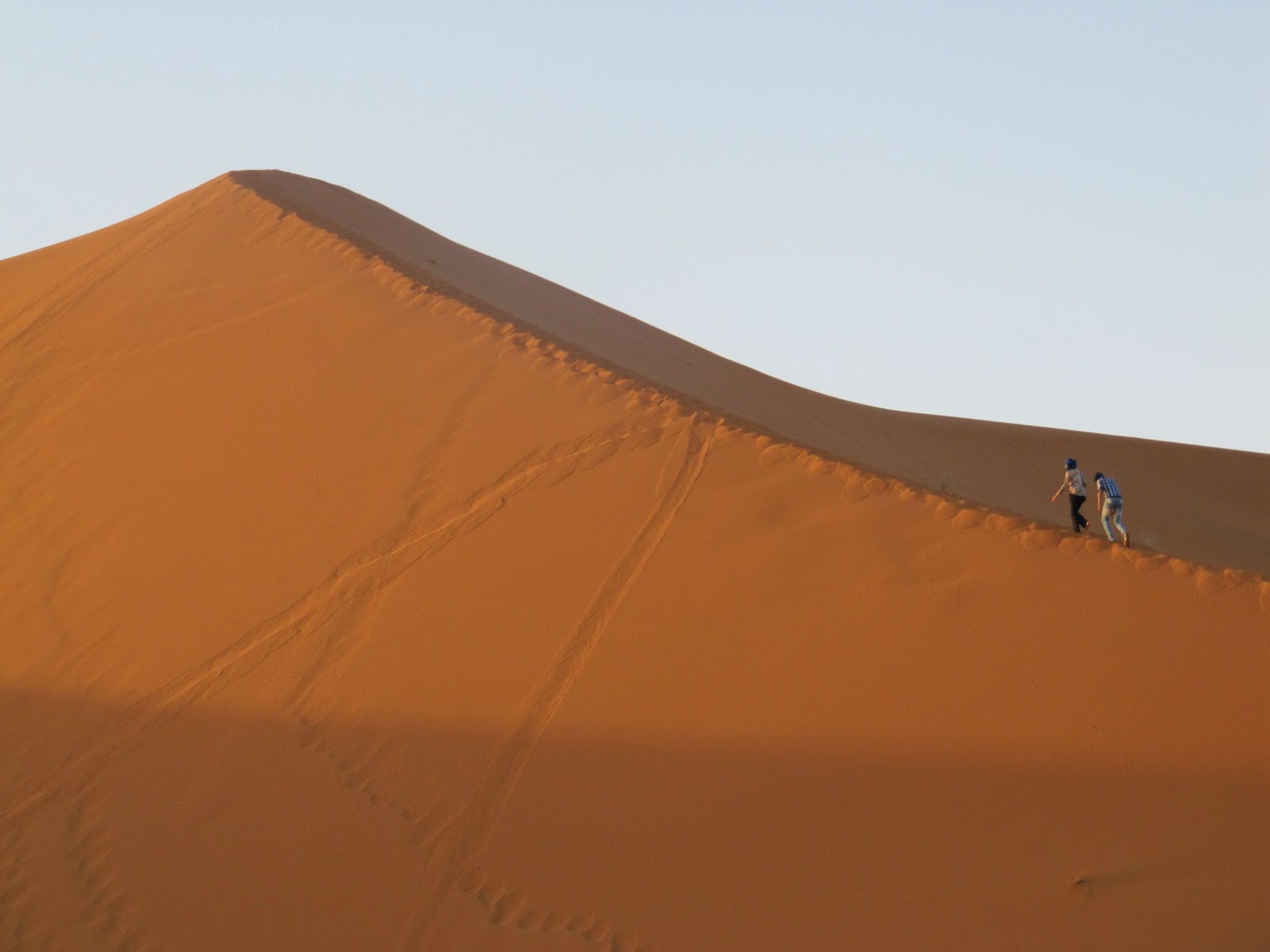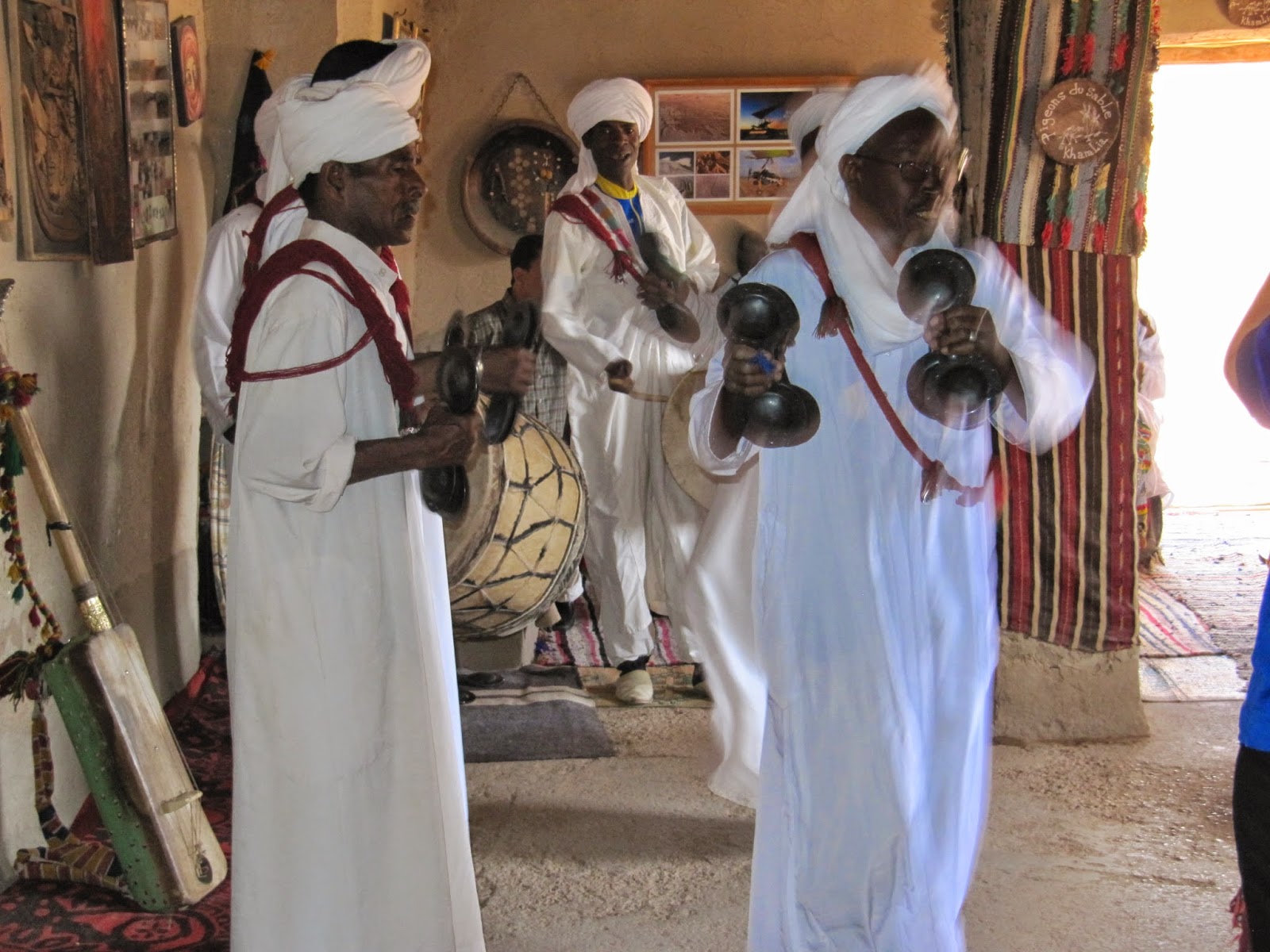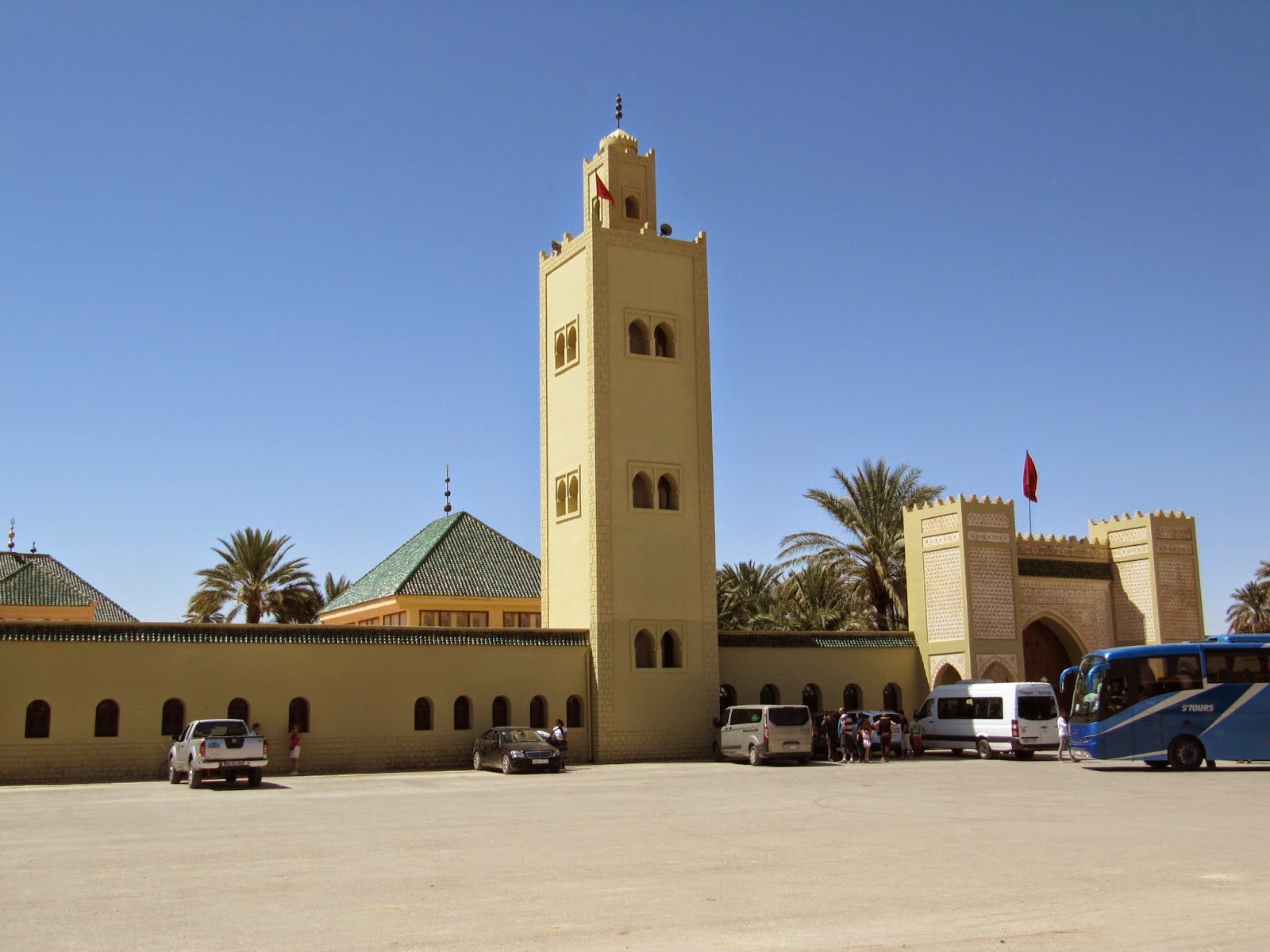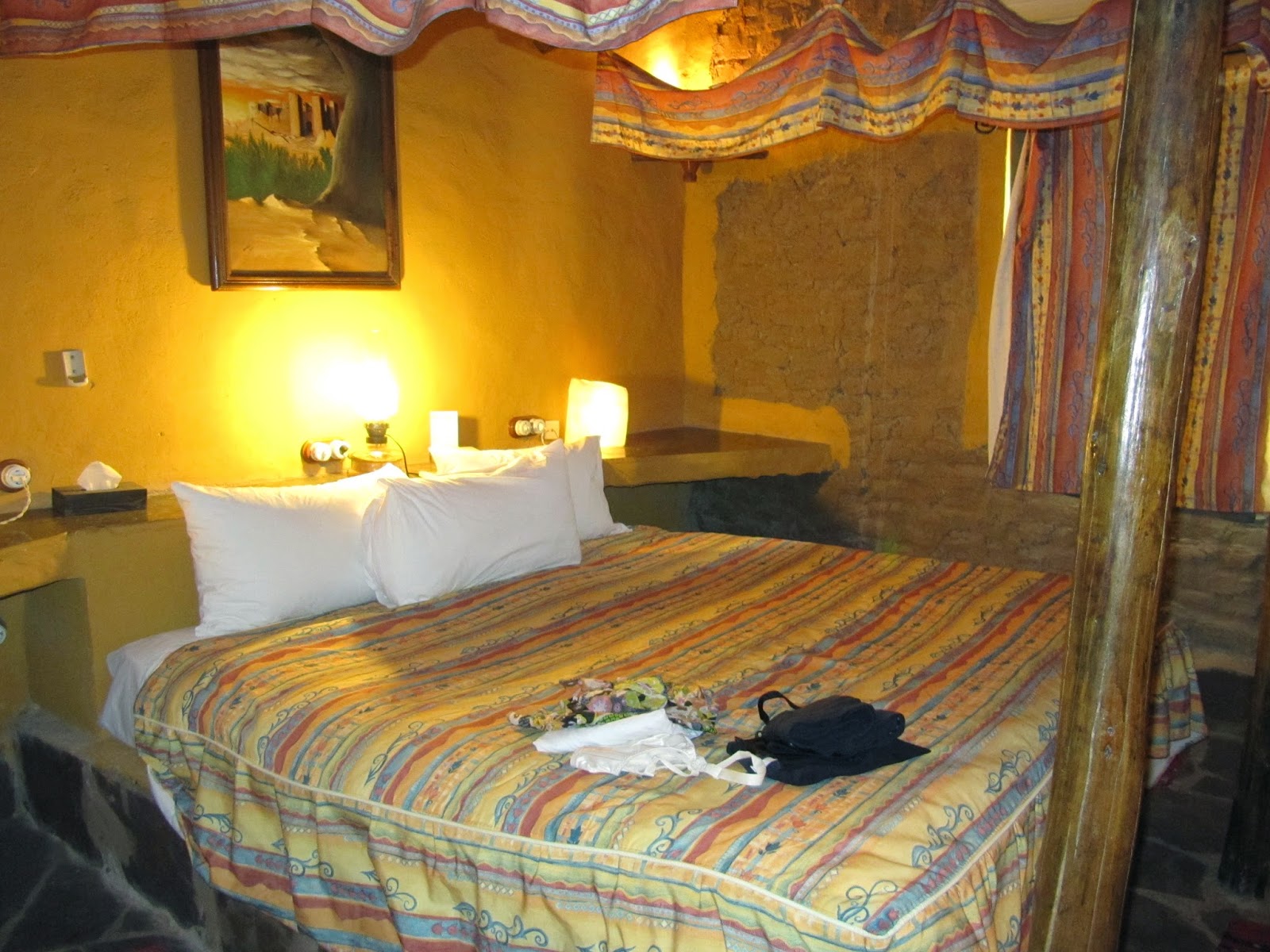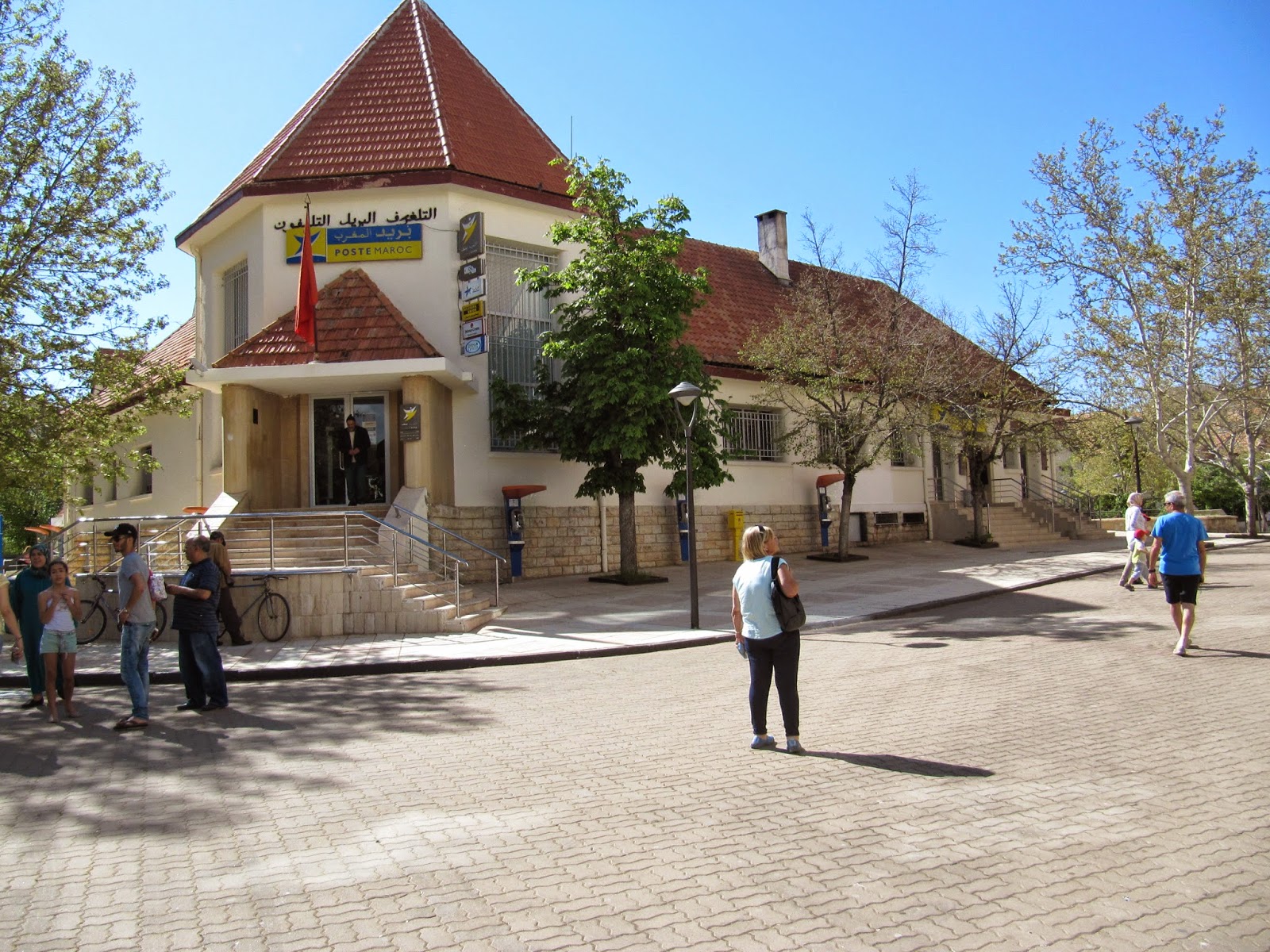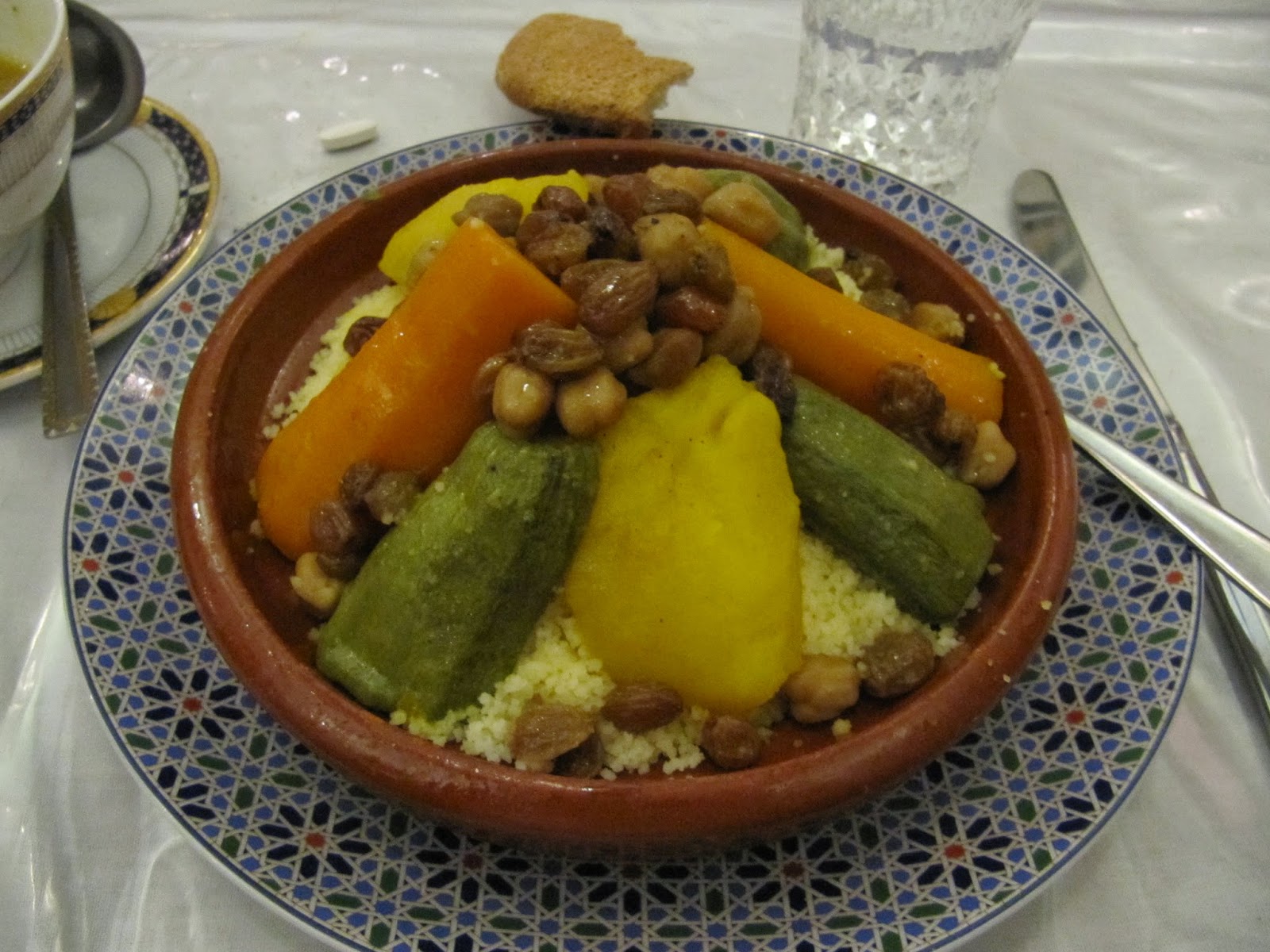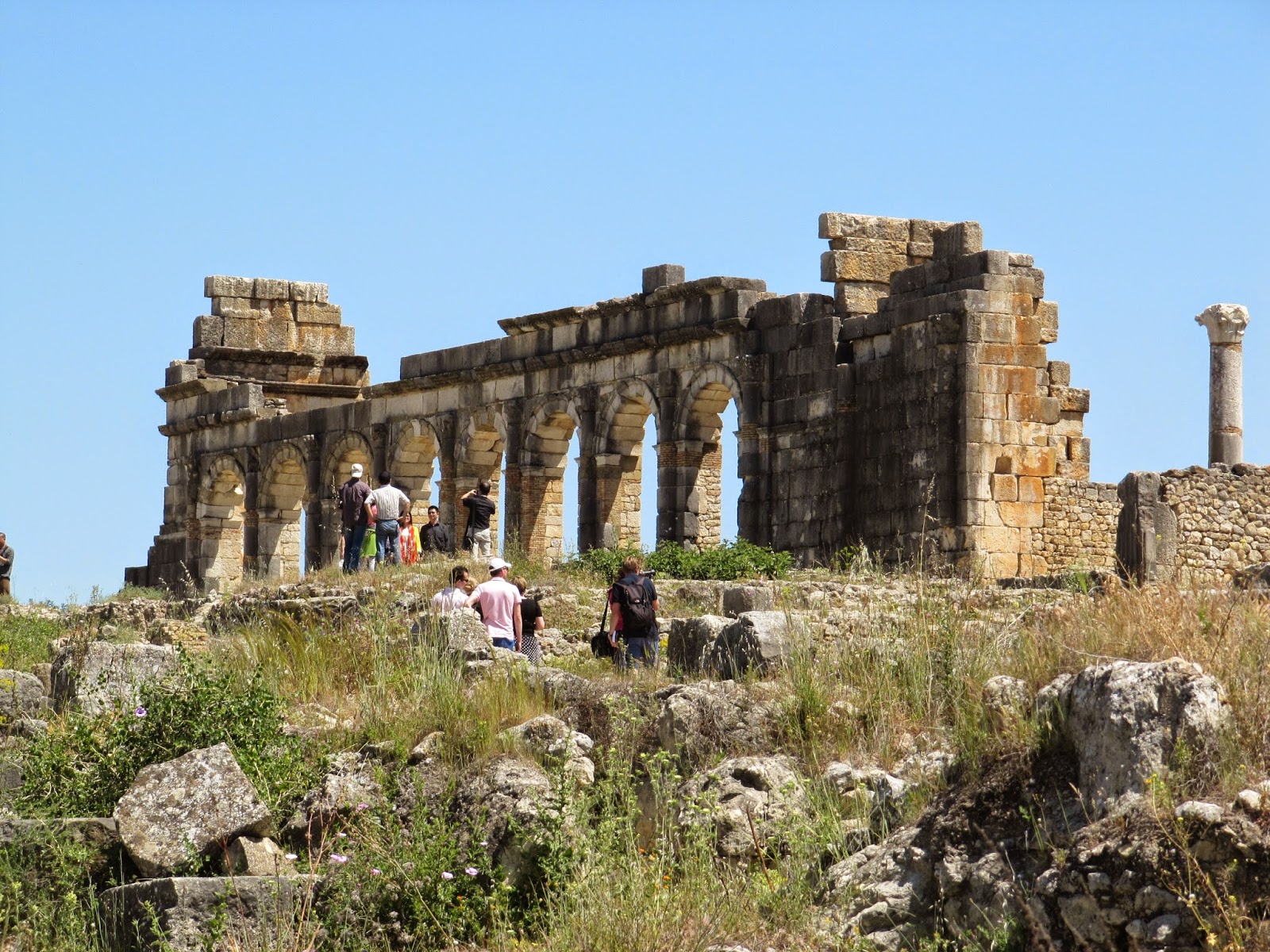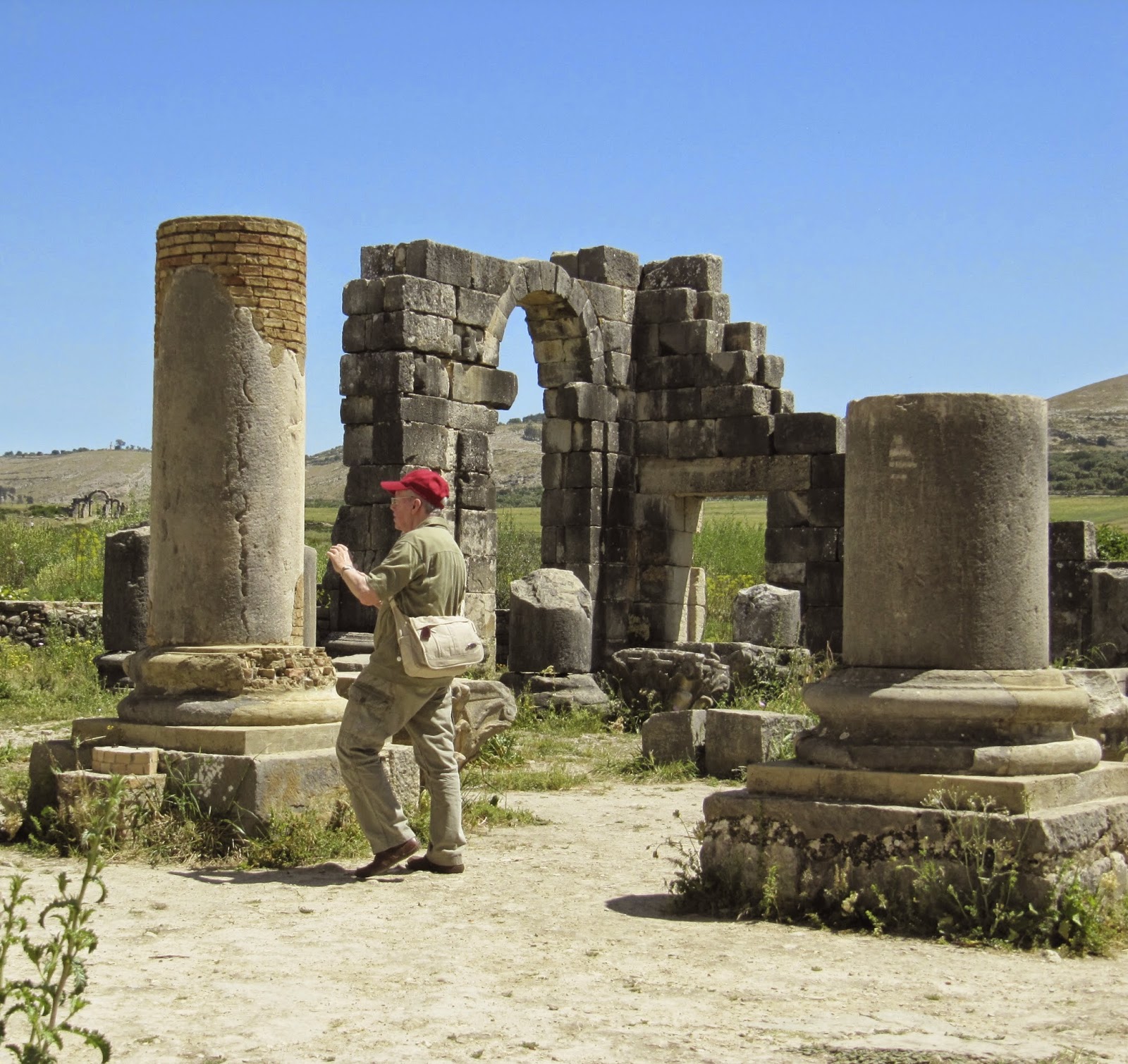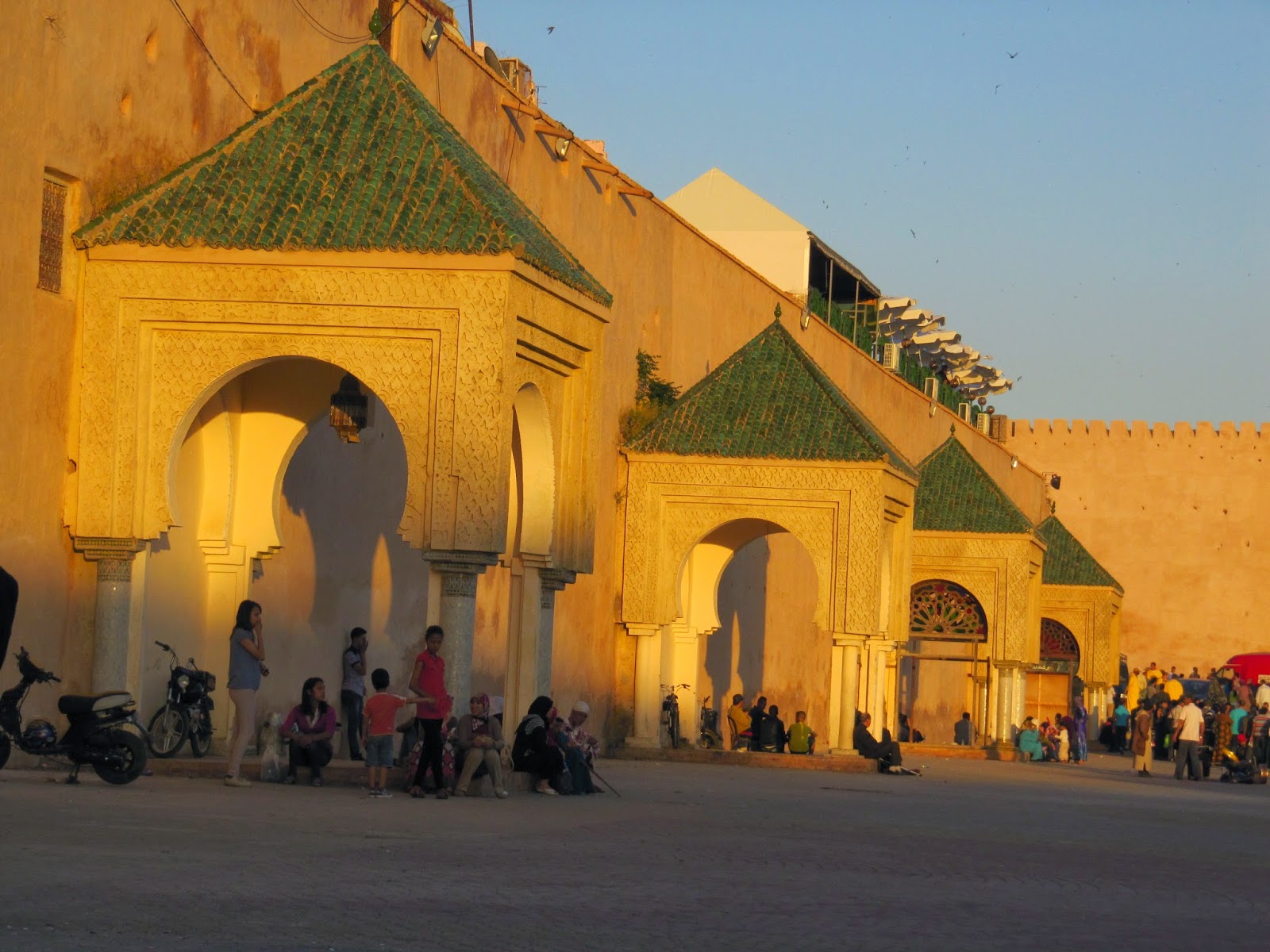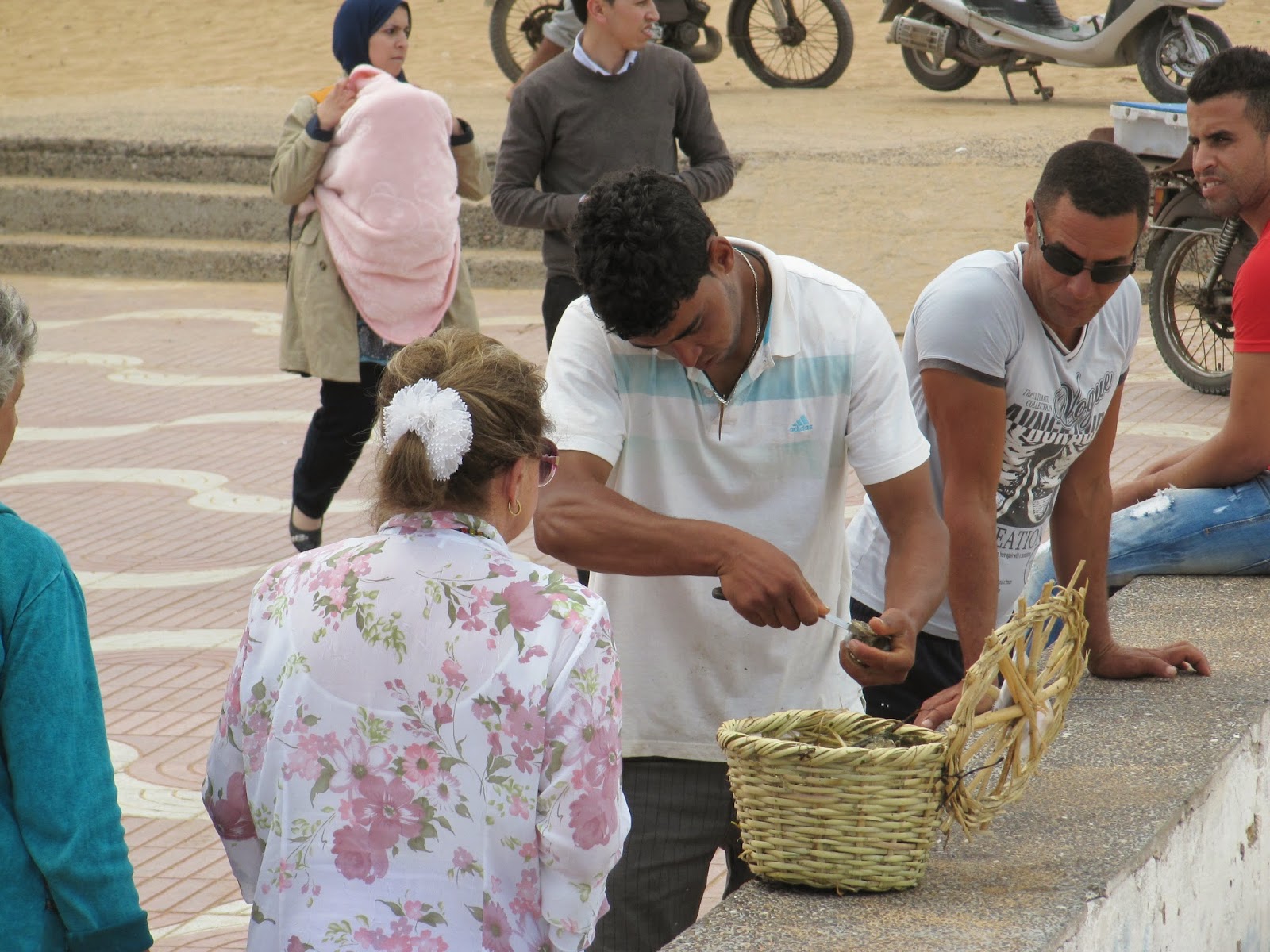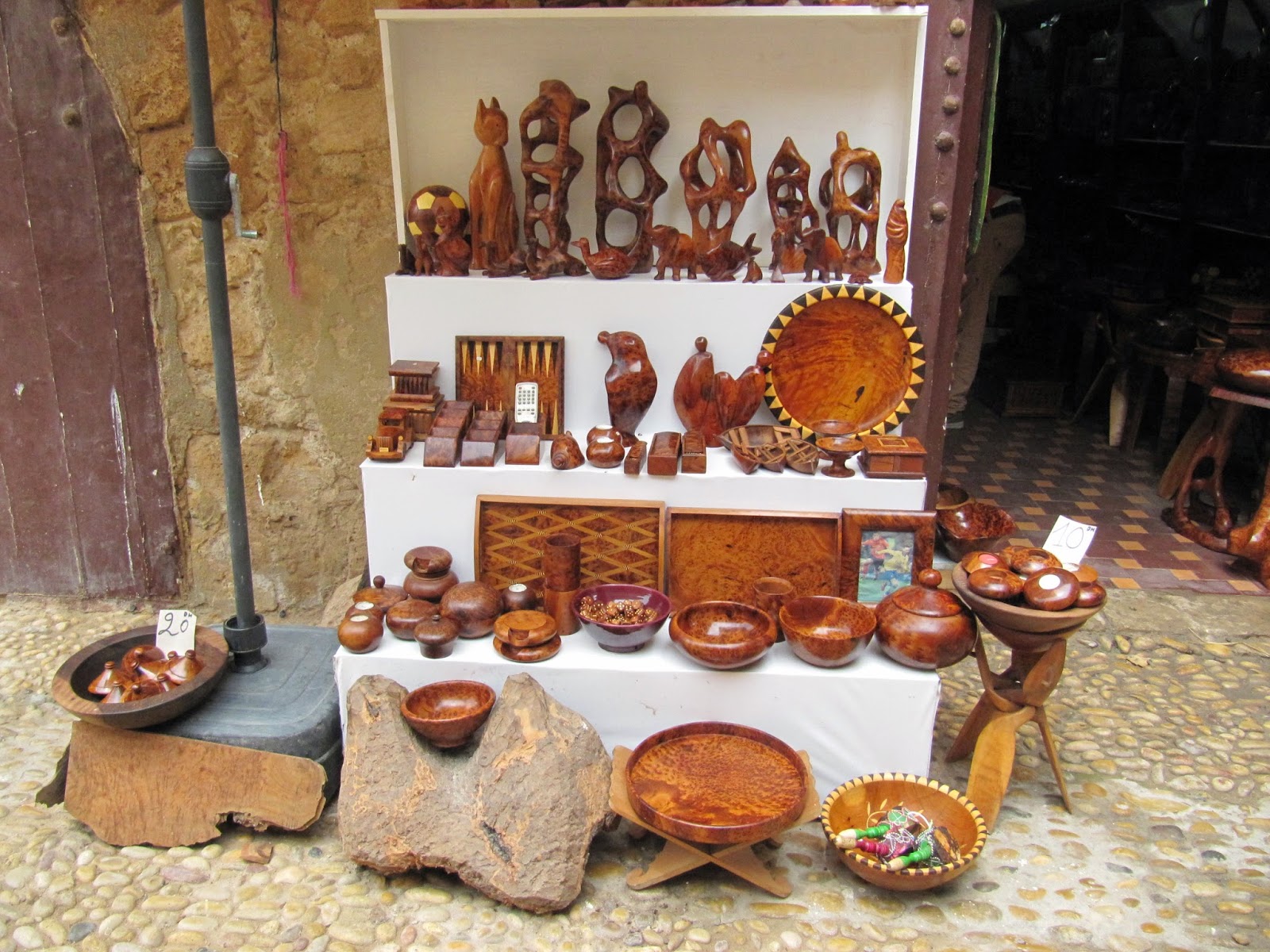My entry into Marrakech at 1:30 a.m. on Monday, April 21, 2014, was not auspicious. Two other women from San Miguel de Allende, Mexico, where we all live, and I had just completed a week's tour of Paris, led by Vicki Challancin. Her flight from Orly Airport to Marrakech left several hours before that of Jude and myself. In an e-mail first thing Sunday morning, April 20, Jude and I received wrd that our scheduled 8 p.m. flight would be delayed by an hour. Vicki had arranged for a driver to pick us up at our Latin Quarter hotel at 4 p.m. He was a half hour early, so we had lots of time to kill at the airport. At the boarding gate, it was announced that the flight had been delayed yet another hour, and later still, another hour, with no explanation as to why. When a third announcement said it would be another half hour, there was a near riot, as several men got up and started screaming their complaints. Airport police were called and that uprising was quickly quelled.
We finally got off on our two-hour flight around 11:30 p.m., arriving in Marrakech at 1:30 a.m., except there was a one-hour time difference, and suddenly it was "only" 12:30. The hour spent going through immigration and customs was chaotic and by the time it was over, we were totally worn out, and now it really was 1:30 a.m. local time. When we finally appeared, Vicki and our driver had been waiting for us for six hours! Only after several days did we learn that all flights in and out of Marrakech that day had been delayed because of high winds, and thus all kept getting later and later. Our flight out of Orly had come in from Marrakech. An explanation of that in Paris would have gone a long way to calm angry passengers.
Because our riad (a large traditional Moroccan house built around a central courtyard, often converted into a hotel) was deep in the souk (marketplace or bazaar), our driver could get us only so close, and because of the hour there were no men with charrettes (carts that can be rented to move anything) to transfer our luggage, we schlepped it ourselves in the darkness through the shuttered souk to Riad de L'Orientale. We were quickly shown to our rooms by a lovely young man, Azzadin, who carried our luggage up the winding stairs, and we fell into bed exhausted. The following morning allowed us to see where we were and to have a delicious breakfast in a little inside nook just off the courtyard, as it was cool.
Door to my single room on the second floor.

View from the bathroom. This design of door opening is quite common and is called a keyhole arch. The door itself is rectangular; it's just the opening that has this traditional shape. There was a small sitting area in addition to the bed.

The open-air courtyard. The little tiled pool was filled with water and some rose petals. The candles in the lanterns were lit at night, casting intricate patterns.

A double room, just off the courtyard.

Vicki in one of the public areas off the courtyard with Missy.

Breakfast is served! It included fresh-squeezed orange juice, home-made yogurt with a touch of rose water, four different kinds of breads with butter, honey, a variety of jams, and tea or coffee. My favorite bread was the one with holes, called beghrir, which reminded me of Ethiopian injera. Other mornings, we had fruit and even eggs, but this was the standard (delicious!) fare.

Marrakech
Since the other three women weren't arriving until the next day, Jude and I accompanied Vicki out into the souk so she could orient us and then do some shopping. The souk was the complete opposite of the way it had been the night before. All of the stalls were open and it was bustling.
This is the little alleyway on which our riad was located. That's our doorway on the right next to the green leaves. Can you imagine us dragging our luggage through here in the middle of the night? Happily, Vicki's tours always stay here (and it was her 9th trip!), so she had a perfect understanding of where it was located.

Just to demonstrate the incredible complexity of the souk, here is a map of a tiny fraction of it on the back of a business card for Warda La Mouche, a delightful handmade women's clothing store in which we all spent a great deal of time and money. These maps are common on the reverse of business cards, for without them, you'd probably never find the same store twice.

At the first corner we came to, we saw cats...a lot of cats. A lot of hungry cats.

Happily for them, a kind man was bringing them fish in a basket. From the way the cats behaved, it appeared as if this was something the man did regularly. By the way, that cart is a charrette, what we didn't have access to the night before for transporting our luggage.


Right across from the cats were these old, beautiful tent poles for sale outside a shop, and I knew for sure at that point that we weren't in Paris anymore.

We were hysterical seeing these 'hanged" child mannequins modeling clothes for sale in the shop. We saw this type of display frequently on our travels.

Sometimes they were headless, which was even weirder.

Here is where the souk opens out onto Place Jemaa al Fnaa, the center square of the medina, an Arabic word meaning city, but it takes on the connotation of the old sector.

Just like Mexico, this country does not subscribe to the "less is more" theory of retail display.


These are spices and we figured out that the high peaks are forms onto which the spices are glued. Otherwise, in a brisk wind, they'd be gone.


A few more views of the square.



A huge percentage of the vehicles in Morocco are Mercedes, including all of the taxis.

One thing I didn't understand was why all of the olive sellers were right next to each other and displayed their identical wares in the exact same manner.

The same was true for the dried fruit sellers.

All of these wares were meticulously displayed, fresh and clean.

It was explained to me that these vendors followed the old European guild system, grouping, for example, cobblers, blacksmiths, etc. next to each other.
In one area of the square were dozens of these horses and buggies (calèches) waiting in line to give tourists a ride around town. We did this later in our visit.

Guess what is behind that magnificent floral display across from the buggies.

Ready? I was really surprised!

My first view of the minaret of the Koutoubia mosque, from which we could hear the call to prayer five times a day. This landmark of Marrakech is the largest mosque in the city, and was completed in the 12th century.

We walked quite a while to the modern part of the city so that Vicki could shop for something she needed to continue on the trip. Of course we used that opportunity to browse in several lovely (chain) clothing stores. All of the large cities we were to visit also had modern sections, but they were just like any other modern city anywhere in the world and thus not interesting to us. We mostly kept to the old parts. On our way back from our shopping trip, we stopped for lunch at Restaurant Koutoubia, one of several restaurants in the luxury hotel Les Jardins de la Koutoubia, named for the Koutoubia gardens directly across the street.




Even the ladies' room was elegant with hammered copper sinks and roses and their petals everywhere.

We relaxed over our salads, with which we were delighted, accompanied by some delicious fresh bread, and little dishes of the ever-present olives (although we were never given a container of any kind to put the pits in no matter where we went).



We were all pretty wiped out from our short night, so returned to the riad to rest until dinner. On the way back, we again meandered among the shops in the souk. Vicki introduced us to some long-time merchant friends of hers, and they couldn't have been more pleased to see her and to meet us.
We were entranced by the opulent displays in a wedding store.

These are favors for wedding guests. Not sure what one puts into them. Maybe confetti.

For dinner, Vicki took us to Portofino, an Italian restaurant just outside the main square, and one of the few places in town where you can enjoy wine with your dinner. Even though Morocco has a thriving wine industry, some products of which we sampled and approved, Muslims do not drink any alcoholic beverages, which is great to my way of thinking, as it eliminates a whole host of problems that can go along with that practice. Only high-end restaurants, many riads (ours included), nightclubs, and some supermarket chains can sell alcoholic beverages. Although the service was conducted at a snail's pace in the largely unpopulated dining room, when the pizza finally arrived, it was excellent. And afterwards, some of us sampled exotic ice cream flavors from a cart near the restaurant.
This might be a good time to give you some information about Marrakech. To quote the materials that Vicki gave us, "Marrakech is one of Morocco's four Imperial Cities (including also Fez -- sometimes spelled Fes -- which pre-dates it as an imperial city by several hundred years, and Meknes and Rabat, which came later, all of which we were to visit) and was established in 1062 (this is before the Norman Conquest of Britain) as part of the Saharan Trade Route. Marrakech existed as a crossroads and regional center before it was established as an imperial city with all that that entails.
The centuries have been kind to Marrakech; it now offers the visitor an alien culture that is mysterious, exotic, and dramatic -- yet not threatening. The city is a vibrant mix of African rhythms, Arab and European culture, and pulsing humanity. In spite of the number of tourists, it is easy to view traditional Arab life as it unfolds around you on a daily basis. In a group or on your own, you will encounter hospitality wherever you go. I promise you this: you have NEVER experienced anything like it!"
The next day, April 22, the three additional women in our tour group were flying into Marrakech from two different places and arriving at two different times, each requiring that Vicki and her driver be at the airport to receive them. Since the first arrival was in the early afternoon, we went out early.
Here are Jude and I in the main square, ready to take on Marrakech.

I was thrilled to capture this photo of a crescent moon over the minaret of the Koutoubia mosque. I mean, what better shot is there in a Muslim country than this?

Look carefully at the mountains in the background; they are snow covered. By the time we returned to Marrakech from our trip around the country about two weeks later, that snow was almost entirely melted.

I loved the look of these directional signs in both English and Arabic, especially since we were slated to visit almost all of these places.

A stunning balcony with a traditional look in an apartment complex in the modern section.

A good example of the kind of place you'd encounter in the new part of town.

And an unfortunate one. It was actually the only kitsch I saw on the whole trip.

Vicki took Jude and me to a government-run artisans' market where there were craftspeople doing their work and many lovely shops.
The photos below show the magnificent entrance to this market.


After spending a lot of time there, Vicki said she needed to return us to the riad so that she could go to the airport for the first arrival. There was no way we were going back, so Vicki drew us a simple map and left us. After some more time on our own at the artisans' market, where we shopped and bargained successfully, we returned to the restaurant from the day before (the only one we knew!), and had another great salad lunch. I actively dislike bargaining, but it's the way business is conducted here. When the merchants talk of it in English, they use the word "haggle." I don't even like the word, let alone the practice.
Then Jude and I were able to find our way back to our riad. Jude wanted to rest (we were still pretty wrecked from our killer pace in Paris), but I wasn't finished browsing the artisans' market, so back I went. I was rewarded by several jewelry purchases, a long skirt that was hemmed for me on the spot, a light purple sweater coat, and other happy finds. When I returned to the riad to meet up with the new arrivals, Vicki called me "fearless"!
This is probably my favorite jewelry purchase (of many!) from the trip. I didn't care for the original chain that was on it, so I swapped it out for the one you see here. I wanted to pick up the "balls" theme in the chain.


I can use the same chain with this set or, once back in Mexico, I might buy a chain just for it. This is the Hand of Fatima, a symbol of protection, and commemorates Fatima Zahra, the daughter of Muhammed.

I met the new travelers, Claudia and Carolina, both Mexicans, who had flown in from Mexico City. Soon thereafter, Vicki had to return to the airport to welcome Sandra, who was coming from Tulsa, Oklahoma via Heathrow Airport in London. When they did not appear by close to 9 p.m., Claudia asked if there were dinner plans. Of course, it had been Vicki's plan to have us all eat together at a more reasonable hour, but she was not there, so I suggested we return to Portofino (again, the only dinner restaurant I knew, with the added benefit that I knew how to get to it). It was totally packed, perhaps because of the later hour than the night before, and service certainly didn't improve under those circumstances, but we were able to have a glass of wine and a nice, although very late, dinner.
When we returned, Vicki and Sandra had still not appeared. We learned later that, because Sandra had used two different airlines for her trip, her suitcase didn't make it from Gatwick, into which she had flown from the United States, over to Heathrow, from which she was flying to Marrakech, and they were trying to deal with that at the Marrakech airport. Neither airline would take responsibility for the lost luggage. Vicki helped Sandra buy a few pieces of clothing at the airport, and they got back to the riad, sans suitcase, way after we all went to bed. This sad state of affairs continued to dog Sandra and her enjoyment of the trip for its duration, as she had absolutely nothing and had to replace what she could on the fly. In the end, after she returned to the States, she did get her suitcase back, but by then, of course, it was way too late.
The next morning, April 23, the Morocco experience officially began with a tour of old Marrakech. Because it is such an intriguing city, Vicki planned more days here than in any other place we'd visit. Everyone's first order of business was getting to an ATM machine to get dirhams, the local currency. Vicki told us, when figuring out what things cost, to drop off the last zero and add 20%. Some of us had a cheat sheet from a currency exchange web-site she had provided earlier. We had to go to many machines before we all got what we needed. We re-visited a couple of the places and merchants Vicki had previously introduced Jude and me to, and then we made our rounds of the souk. A huge hit with everyone was a tassel shop. Who knew? Seems an odd choice, but tassels are used on virtually anything you could think of, and there were more sizes, materials, colors, and designs of tassels than you could ever imagine. They also had some lovely glass and ceramic bowls, which is where I spent my money.

In this interesting shop, everything was made from used auto tires!

A wood-turner's stall.


These gorgeous, colorful scarves are made of "silk" from the maguey cactus. They make handbags, purses, shawls, bedspreads, etc. from this material.

Jude bought a handbag -- with yes, a tassel! -- made from the cactus silk and leather which we all envied and which served her very well on the trip.

On quite a hot day, we ate lunch way up on the 3rd or 4th floor terrace of Dejeuner de Marrakech, and enjoyed the breezes and the silhouetted cactus.

Again we opted for salads.

With everyone still jet-lagged, we rested in what was left of the afternoon, until dinner time. We went to another favorite restaurant of Vicki's, Chez Chegruni, a popular spot known for good, inexpensive tajines. We sat up on the terrace with a stellar view over the bustling square beneath us. Because this was not a restaurant that served wine, we instead ordered the ubiquitous mint tea, which is always poured from on high with flourish into glasses, not cups.

.
We each ordered a tajine, a north African stew of spiced meat and vegetables prepared by slow cooking in a tajine, originally "frying pan" from Moroccan Arabic, a shallow earthenware cooking dish with a tall, conical lid (removed in the photo below, but you'll see some later) which was lifted with great fanfare.

Because of the location of the mosque right next door, we were treated to the beautiful sight of the sunset lighting it up, and were able to hear very distinctly the evening prayer call coming from the mosque through the loudspeaker which was very close. As we ate and talked, we were able to watch night fall and the lights of the square come on. There was no glass in these windows, although I imagine it could be added when needed.

Vicki's introduction had told us, "At night, the square comes alive with local story-tellers, dancers, entertainers, snake charmers, veiled women offering henna designs, herbalists, acrobats, and general bustling humanity," so out we eagerly went to experience it. The large, open square had been transformed from its daytime appearance to a giant, open-air barbecue restaurant, seemingly mostly for the tourists, as seen in these photos. Hundreds of tables and overhead coverings and probably thousands of chairs are set up every day and then taken down again until it is all repeated the next evening. The whole mass was divided into sections where chefs were busily and crazily preparing food that had been ordered from menus hanging from the tent poles. There were hawkers outside each tent, extolling the food, pointing out empty seats, and ushering diners in. The sheer size of the operation was mind-boggling.




We continued on to take it all in. It was hard for me to believe that every single lamp in this store had a bulb in it that was turned on. I think if you couldn't find the lamp you wanted in this shop, you should just give up.


This display of shoes appeared to me more like a flower store than a shoe store, so cleverly had the owner displayed his wares. Do you think it's possible that he has missed any color, style, or size?

When we were totally saturated with sights, sounds, and odors, we returned to our riad.
The next morning, we headed off to two museums. The first was the small, well-organized gem, Musée Tiskiwin, the collection of Bert Flint, a Dutch anthropologist and collector of North African art. Each room featured traditional cultural objects from across Morocco, much of it Berber. "It's important to understand that although Morocco is an Arabic-speaking country, the significance of the Berber population can't be overlooked. Most Moroccans can claim both Arab and Berber (they call themselves the Amazigh or some version of this word) ancestors, so intermingled are the cultures. The Berbers are fiercely independent and have maintained their language and writing system (which is now -- finally! -- also being taught in the schools) throughout history. The Berbers of today mainly live in the mountains and the desert, with farmers in valleys and oases, while the Arabs live in the cities, along with what we might call 'the Moors.' Berber culture and its history permeate all aspects of Moroccan life today in some way." (Vicki Challancin)
Courtyard of the museum.

I am a total sucker for magnificent doors, as this one certainly is, and you'll see many more of them in this report.

A recreation of the inside of a Berber tent, the stuffed clothes representing a family.


Camel saddles.


A saddle bag.

I'm sorry, I just can't help myself.

When I looked up at the ceiling in one room, I was startled to see that it was of nearly the same pattern as a scarf (with tassels!) I had bought the day before at Warda la Mouche!



After lunch, it was on to the next museum.
In the middle of the teeming souk, a couple is able to carve out a quiet moment.

We walked along a street that was dug up in many places, culminating in a large hole right at the entrance to the second museum, Dar Si Said (House of Si Said), now the Museum of Moroccan Arts, considered to be one of the finest in all Morocco. Originally built as a private home of a very wealthy family in the late 19th century, it was inaugurated as a museum in 1930.

At a gathering, this device (a minbar) could be moved into place so that the imam (usually, a worship leader of a mosque) could stand above the crowd to deliver his message.


There were some amazing textiles. I can't even imagine the amount of work that went into embroidering this piece.


This culture has the decorative arts sewed up! There is usually no surface that is not decorated (magnificently).
umbrella photo

door photo
These are special chairs for the bride and groom in a wedding reception chamber.

These were certainly the most surprising of the displays. What do you think they might be?

They are the individual "cars" (called palanquins) on a hand-cranked "Ferris wheel," that was brought in and assembled for a child's birthday party. Talk about over the top!

Back to the riad, then, to rest until the later afternoon when we reconvened to go to the Jardin Majorelle. This 12-acre botanical garden with specimens from five continents, was created in the 1920s and '30s by French painter, Jacques Majorelle, opened to the public in 1947, and subsequently owned by fashion designer Yves Saint Laurent. Laurent's ashes were scattered in the garden upon his death in 2008, and a memorial to him can be found there. In the photos below, you'll see swaths and flashes of the incredible paint color, Majorelle blue, that is used throughout.

The garden is meticulously maintained, with nary a pebble out of place.

The bamboo garden.


Here are Vicki and Carolina under some incredible bougainvillea.



And here are Claudia and Jude looking smashing in front of the Majorelle blue wall.

We spent some time in the Berber museum on the grounds, which is housed in the former painting studio of Jacques Majorelle. There were jewelry, weapons, leather goods, basketwork, and woven textiles representative of the richness and diversity of the still-vibrant Berber culture.
We finished off our visit with a little refreshment in the outdoor cafe, and then when we were invited to leave, as the garden was closing, we did so through a cactus garden.

Here's what Coca Cola looks like in Arabic.

Because Vicki knew that the riad was able to turn out more than just breakfast fare, we had asked that dinner be prepared and served to us, with wine up on the terrace first.

Back downstairs for dinner, our delightful waiter, Azzadin, unveiled the family-sized tajine, and the wafting scents were intoxicating.


Because there was a lot left of a sensational tomato "sauce" condiment that we all went nuts for, we asked if we could re-visit it in the morning over eggs, and our wish was granted. Of course we also had all of our usual breakfast delights.


Cooking Class
There were many highlights in this trip. What we did this day was one of them: a Moroccan cooking class held at the suburban outpost of La Maison Arabe, an exclusive luxury hotel within the medina. We walked to the hotel and then along with the other members of our 16-person group (except for our group, the other students were all young, which was surprising, and four of them were men; most were European), we were whisked in two vans out to the cooking school.
First, led by two charming and attractive young women with their hard-working helpers, we had a lesson outdoors in Moroccan bread preparation and the proper method to prepare mint tea. Happily, we got to taste-test both.





Even though I had just had a hearty breakfast, I couldn't stop tasting this incredibly-delicious fresh-baked bread dipped in olive oil.

Then we walked a short distance to the cooking school's kitchen, which was state-of-the-art and not at all what I was expecting, but then I'm not really sure what I was expecting. We were given aprons and name tags. First, we gathered around the chef's cooking area while she showed us how to make coconut cookies, Morocco style. Surprisingly, a flatish bowl about the depth of a pie plate was used to make the dough, and only a hand was used for mixing, no utensils. After the dough was mixed, we each took a turn forming a ball, dipping it in powdered sugar, and placing it on the cookie tray to bake while we made the rest of the meal.


Then in pairs, we went to our work stations where we shared a variety of spices plus a monitor, showing close-up what was happening at the front of the room. We each had our own tajine and small frying pan set up on a two-burner cooktop, knives and other implements, and a dish of fresh foods right out of the fridge that we'd be using in the preparation of our lunch.

I cannot begin to tell you how much personality the chef (the woman in the scarf) had -- that of at least 10 people! She and her helpers made the lesson so much fun, as they walked around helping those who were having problems, praising our efforts, and even asking who had a birthday that day (and one man did), and then recognizing them with much applause and ululation (a unique trilling of the tongue against the roof of the mouth).

After we made the chicken, vegetable, and olive dish that we set to cook in our tajines, we started on two side dishes. First, we were taught to make a tomato skin rose by peeling a tomato without breaking the peel, then just wrapping it around itself. My first attempt at this was perfection; the second one, a complete failure.

This was an eggplant side dish; the other one was a salad, so lots of chopping was involved.


I wondered how we were going to be united with our own tajines when it came time to eat. They were way ahead of me and asked each of us to put our name tag on our tajine.

While a small army of helpers moved our tajines and side dishes to an outdoor terrace, we had a lesson on spices at the school's small shop.

Vicki had ordered a flight of wines to accompany our lunch, and so we floated home sated and happy after eating our creations and then a special mille-fleurs (a thousand flowers) dessert, also known as a Napoleon, and our very own coconut cookies.


Since this was to be our last day in Marrakech except for the partial day before we flew home, we, of course, did some shopping. At dusk, we went out into the extremely crowded square to take our long-awaited horse and buggy ride.


A highlight was seeing dozens of nesting storks, considered good luck.

This is Baab Agnaou, sometimes just "bab," one of 19 city gates, complete with storks.


Before returning to the riad to pack up and get a good night's sleep before our excursion around the country, we stopped at one of the dried fruit stands and loaded up on all manner of fruits and nuts "for the road."
Road Trip Begins - Aït Ben Haddou and Ouarzazate via the High Atlas Mountains
The following morning, April 26, we were off early on the next part of our adventure! Our guide for the next 11 days, Ali, came to the riad along with several men with charrettes to take our surprising amount of luggage to the Mercedes Benz van out in the square, where we met our driver, Anas.


I was charmed to see oriental rugs under our feet! We started out playing musical chairs every time we got back into the van after a stop, but soon settled into what became our permanent places.
oriental rug photo
This is a map of the top half of Morocco; there is about the same amount of country below. I am pointing to Marrakech.
map photo
A bit of info on the country before we set out: The capital is Rabat. Arabic and Berber are the official languages; French and Spanish are also spoken. Morocco is bordered by Algeria in the east, Mauritania in the south, the Atlantic Ocean in the west, and Spain in the north. As you may be able to see at the very top of the map, there is only a small distance between Morocco and Spain. Our flight from Paris was only two hours, and I understand that a ferry can be taken from Spain to Morocco and back. No wonder the towns we visited were packed with European tourists.
Morocco's landscape varies from coastal lands near the Atlantic to mountainous regions to the Sahara Desert (and we saw them all!). The population is around 32 and a half million, over 99 percent of whom are Arab-Berber. Morocco gained independence from Spain in 1956 under Sultan Mohammed V. Their beloved young king, Mohammed VI, took the throne in 1999. He has advanced some of the liberal policies that his father had started. His motto is "Modest and Modern." He and his family do not live in the royal palace; they have an apartment nearby. He drives himself to "work." He has shown particular favor toward women's rights. In 2002, he married Salma Bennani, a computer science engineer, not a traditiuonal pairing for a monarch of a traditional Muslim country, and many believed it symbolized the acceptance of more modern roles. They now have two children, a boy and a girl.
Economic development has been the government's priority recently, although it has been hampered by the country's challenging geography and climate. The economy is driven by agriculture, but there have been droughts. And unemployment runs high -- 10 percent on average, and higher in the cities, which creates a challenge for young people seeking an entry-level position. I can tell you that tourism is absolutely booming!
In 2011, a new Prime Minster from the moderate Islamist party was elected. The king is dedicated to keeping fundamentalism out of his country. (Thanks to Overseas Adventure Tours for most of this information.)
Today's goal was Aït Ben Haddou and Ouarzazate via the Tizi N'Tichka pass in the High Atlas Mountains (21,000 ft. at their peak), which eventually leads to some of the most spectacular scenery in all of Morocco. The road travels through the full range of Atlas environments from the Haouz Plains through the verdant foothills of the Oued Zat to the barren lunar peaks of the Anti Atlas, and the arid desert regions around Ouarzazate. It's actually not very far from Marrakech, as you'll see from where my finger is pointing on the next map, but the road was almost entirely composed of unimaginable switchbacks through the mountains, which require slow, careful driving. The jiggly line on the map (not really visible in the photo), representing our breath-taking, heart-stopping route, gave testimony to that. Some of us took Dramamine or other meds of that ilk; I chose to suck on crystalized ginger that I had brought with me. It worked beautifully, even though I'm usually a candidate for motion sickness.
We stopped for lunch in the town of Telouet, just about half-way to that day's destination, at a place I would call in the middle of nowhere, and had some of the best food of the trip (not that any of the food was bad anywhere).
Vicki explaining to our waiter in French what we would like to order. Vicki also speaks Spanish and English, and a smattering of Arabic, which floored some of our local guides. She frequently had to translate into English for the majority of us and then into Spanish for one of our travelers with limited English, and did a stellar job of it, but sometimes became tongue-tied with all of the languages whirling around in her brain. As Carolina became more comfortable with her English and I and others with our Spanish, we had a lot of fun speaking to each other in those languages. This was an unexpected added value to the trip.
This was my portion of the four salads we started the meal off with. As always, just delicious.
Then we had ordered a chicken tajine with nuts and fruits,
and one with beef and nuts and fruits for us all to share.
This beverage was one of the best drinks I've ever had. It had an orange juice base and contained almonds, avocado, dates, and maybe bananas.
After lunch, we visited one of the most spectacular kasbahs in the Atlas, Kasbah de Telouet. Perched high in the mountains, it was one of the homes of the Glaoui dynasty and is considered one of the most scenic spots in the Atlas. A kasbah is a fortress, built for defense. (Medinas, which I've written about here, are also kasbahs.) Usually built on a hill with high, windowless walls, kasbahs were a place for local leaders and townspeople to live. Almost all cities had kasbahs, as they were necessary for their survival.
As you can see by this photo and some others, the kasbah is in need of some drastic repairs, and they are on-going.
We spent quite a bit of time (and money) in this fabulous complex of shops, run by two brothers who specialize in ethnic art, antiquities, and rugs. I bought the necklace shown below. Just before coming on the trip, I had bought earrings in San Miguel whose design had called to me, and I could immediately see the similarity in the motifs. Through that, I could imagine history at work: the design perhaps originating in Morocco, then taken to Spain, and finally to Mexico. It's not a stretch at all.
In the afternoon, we arrived at "the strategically located Kasbah of Aït Ben Haddou, one of the largest complexes of traditional packed-earth buildings in Morocco. A UNESCO World Heritage Site, this graceful walled city affords both spectacular views as well as a glimpse into life as it was in the days when families and tribes banded together for protection in self-sufficient fortresses. It is one of the most exotic and best-preserved kasbahs in the entire Atlas region, and has been featured in more than 20 movies, including 'Lawrence of Arabia' and 'Jesus of Nazareth.'" (Vicki's materials.)
This was our first sighting of camels.
We were pretty done in from our long day in the van and a great deal of time spent in Telouet, and chose to view the magnificent kasbah only from below. We noted that nearby hillside locations were used to film parts of "Gladiator."
This photo shows the distance covered in our first day of travel, as my finger points to Ouarzazate, our first overnight stop. I kept up with our daily progress with a marker, although I got a few things wrong. Please ignore the left and right orange lines going up into the country to the right of my finger indicating Ouarzazate. We actually took the road indicated by the middle orange line to the right of my finger to view the Todra Gorges (more on this later when we get there).
Riad Dar Chamaa, a charming new place run by a lovely Spanish family, was our lodging that night; dinner was at the riad.
Skoura and the Dadès Valley
Always a strategic location, Ouarzazate now serves as the base of the growing Moroccan film industry. "Kingdom of Heaven," "Jewel of the Nile," "Sahara," "Cleopatra," and even "Star Wars" were all filmed here. The studios have become a bit shabby over time, but nonetheless, we were game to visit the Cinema Museum of Ouarzazate. Just keep in mind that everything you see in the following photos is fake; welcome to a styrofoam world!
Not Jude of course! She's the real deal.
I didn't see the movie, but this cell was used in "Gladiator."
We had a lot of fun sitting in this throne for photos. Here I am striking what I hoped was a regal pose.
Movie posters were everywhere.
Right across the street was the Kasbah de Taourirt, the largest from the Glaoui dynasty and a World Heritage Site, so of course we went to see it.
Naturally we all had to stop here to have our photos taken.
We rode through the Valley of the Roses to Boumaine, a center for rose cultivation and the perfume industry. Stopping at workshops or factories of various kinds was one of the highlights of the trip for me; here we visited one which processes roses to extract their oil. It was very small. A handful of women start the process by picking the petals off of roses. We were told that it takes 5000 kilos of rose petals to extract one liter of rose oil.
Most scarved or otherwise covered women in Morocco don't like to have their pictures taken, so that is why I show only the hands of the workers in the photo below. I even had to show one of the women the photo to prove to her that I hadn't taken a picture of her face, only her hands. I simply cannot imagine standing up for eight hours a day picking petals off of roses, can you?
Drying racks.
Tank of distilled water.
One wall of the exquisite products in their lovely shop. I bought three bottles of the highest grade of rose oil as gifts. My sister, Julia, who uses rose oil from other countries in her massage practice, was shocked that this rose oil was clear; all other rose oils she'd worked with in the past were not.
Next stop was at the Itrane riad for lunch with a beautiful view.
We shared a salad, some bread, and a Berber omelet.
That night we put up in Boumaine Dadès (where I'm pointing on the map below) at the fabulous new sort of African safari-themed Hotel Xaluca Dadès. (Ignore the line going up into the country where my finger is pointing. We did not go up there, but rather up the next line to the Gorges of Todra -- tomorrow.)
At the entrance to the hotel we and other travelers were met by an energetic and entertaining dance troupe.
I had brought a bathing suit and, with a couple of hours to relax before dinner, I was determined to use it. However, the pool was unheated and absolutely freezing. Folks from all over the world lounged around it; no one was brave enough to go in. I observed the other travelers and took photos of the scenery in some exquisite light. The over-sized "bed" was one of the places you could choose to loll around the pool.
Dinner was buffet style, the first we'd encountered. It was a huge hotel, but they had volumes of food and the hungry diners very much in control.
The Ziz and Tafilalet Valleys, Merzouga and the Camel Trek!
The next morning, as we waited while our luggage was stowed in the van, we took turns posing -- again regally, I hope -- in one of large and beautiful chairs in the lobby. Tonight was our camel ride out into the Sahara Desert, so we were instructed to dress for that experience (jeans and shoes that wouldn't fall off) and also to pack a small bag with toiletries and other needs for a possibly chilly night.
Just before we entered the Todra Gorges, we stopped and some of us got "scarved" for the adventure ahead.
We took the road I indicated on the map in orange away from the main route to view the Gorges, gorgeous as all gorges are, and in this case, complete with mountain climbers.
We stopped in here for a coffee.
And here was the unfortunate one-man graffiti-removal effort.
Another fabulous lunch of salads!
"The Ziz Valley was once a passage for the Caravan routes linking sub-Saharan Africa to the Mediterranean and still stands in luscious green contrast to the desert that lies beyond. It has an abundance of palm and date trees and contains what is probably Morocco's most important oasis, Tafilalet, an enormous palm grove, fed by the waters of the Ziz." (Vicki's materials)
No trip around Morocco would be complete without a visit to a rug showroom, and here was our handsome and personable salesman. He and his helpers rolled out carpet after carpet for us.
This was a favorite of mine. I didn't succumb at this place, but I did later.
Of course the goods here were not limited just to rugs.
With the help of some experts, the women who had bought scarves for the camel ride got re-tied.
My finger is between Erfoud, to the left, our next night's destination, and the town of Merzouga, where we boarded our camels for the ride into the Sahara Desert to spend the night.
We left our luggage in a storage room of the hotel that hosts the camel rides, took our overnight bags and went to meet our camels.
And their handler.
First up on her camel was the intrepid Carolina!
After a few more brave souls mounted, it was my turn. I may look nonchalant here, but, believe me, I wasn't. It was one of the most frightening things I've ever done, but I did it.
When we were all on our camels, off we went into the Sahara Desert at dusk.

I'm next to last in this iconic photo.
Vicki, who was last in line and directly behind me said she could tell the exact moment when I relaxed. For about the first half hour, I kept my feet stiffly up, as this photo that she took attests to. I had visions of my camel breaking loose from the group and galloping off with me aboard. (A friend told me that this actually happened to a woman on her tour to Egypt.) But all of these camels were tied together, were pregnant, and had been making this trek for over 10 years. Not much chance of a rogue among them.
Then, finally, I relaxed my feet and the rest of my body, and enjoyed the incomparable beauty of the remainder of the ride.
After about 45 minutes, our abode for the next 12 hours or so finally came into view. We saw that some other travelers were already there.
The high grey shape indicates the tent with what we were told was an incredible luxury in this setting: a flush toilet. That's the water supply.
Our hosts for the experience came to greet us.
Here's how this jumble of Bedouin tents looked in the interior. My tent is in the lower right corner.
And here I am happily sitting in it.
The fresh water for our stay. I love the absence of the mirror from its frame. It says it all. One of our members, who will remain un-named, was scandalized that there was no shower.
Dinner was soon served from the kitchen tent to all of that night's guests. Vicki, bless her heart, even brought wine along for us. The other guests were Dutch, I believe, and we enjoyed chatting with them.
After dinner, we looked at the stars. They appeared unlike anything I've ever seen before anywhere else and probably won't ever see again. And the deep stillness was incredible. Buzz Aldrin described the "magnificent desolation" of the moon, on which he had landed, and I imagine that what I was experiencing was similar. There were no electric lights, so we all went to bed early. I had a fantastic night's sleep. We had been warned to come prepared for wind and/or cold, but we had neither. Several days later there was very high wind, so we felt quite fortunate. The flashlight I had brought came in handy for a midnight trip to the "bathroom."
The following morning, we arose at dawn for our return trip, as breakfast would be served at the hotel.
We did have some time to walk around and take photographs before we re-mounted our camels. Some of us, not including me, even climbed the dunes.
Some of the Dutch teens had brought their snowboards to try their luck on the dunes.
If you ever get the chance, don't bother. It didn't work.
I captured some amazing sights in that early-morning light:
Camels' bodies suck all of the moisture out of what they ingest, so that their waste is exceedingly dry, comes out hard and round, and, on an incline, will roll. Desert dwellers amuse themselves by cheering on their camels' poop as it rushes to the bottom of a dip between the dunes in a contest with others'. And here is the infamous dung beetle (of the scarab family), who rolls the camel dung to its dwelling as a food source.
The getting up and down was the part that terrified me. This was to have been the order for our return, with me in second place, but my camel was not at all happy about that and was making some odd noises, so they put her in front. All was then peaceful. The handlers really knew their business and their camels.
Back at the hotel, we had a hearty breakfast on their delightful patio.
We didn't have far to go that day to our next destination, Erfoud. We had planned for it to be a short day on the road so that we could rest up for the next one, which was to be a killer, going all the way north to Fes. Our first stop was at a village of descendants of former Sudanese slaves who specialized in their ancestral music, Gnaoua, and dance. The musicians call themselves the Pigeons of Sable.
Of course before the entertainment began, we and the other guests from other tours were offered mint tea.
We all fell in love with this little boy who so seriously followed his father's lead and played his instrument.
I was enamored of the very different type of castanets they played, and bought a set for my son, also a musician, when we got to Fez.
When their presentation was over, they asked various of us to dance with them, and I was delighted to be one of those asked. I was still wearing my camel trek clothes -- oh, dear -- as we hadn't had access to a shower or change of clothes following that adventure.
I saw this group of men, perhaps a council of some sort, speaking heatedly as we left this fascinating place.
Then it was on to the mausoleum of Ali Cherif (1589-1659), considered to be the founder of the Alaouite Dynasty of Morocco. We very much enjoyed the courtyard and gardens there.
The photo below so reminded me of Muslim sites I had visited in India.
We were allowed to peek in the door of the magnificent and enormous prayer room of the mosque.
Then we went to visit a shop (that word does not begin to describe the place), where after a short course on telling old, tribal jewelry from a modern knock-off, we were handed little straw baskets ("shopping carts," our host joked), and we eagerly filled them up.
Here are the Berber Crosses used by the tribes to navigate by the stars, and passed down from generation to generation for good luck and protection. Based on these designs are a myriad of necklaces and other jewelry.
I'm not sure that I bought all of the pieces below at this location, but thought you might like to see some of the intricate and exquisite -- and relatively inexpensive -- jewelry that is available and which I bought.
Another extreme highlight was a lengthy visit to a fossil factory. Morocco is the second best site for fossils in the world (don't know which country garners the premiere spot), and as we drove around, we often saw men in open fields hitting rocks with hammers to split them open to see if they revealed a fossil that might sell. At the fossil factory, we began a tour by seeing the raw material -- huge chunks of petrified matter, carbon-dated to 250-600 million years ago -- and then a machine that slices it to reveal its contents. Thank goodness that machine was not in use at that time, as I imagine the noise would be deafening.
Here is a worker polishing a slab from the cutting, perhaps to be used as a tabletop.
Other workers made reliefs of the fossils on the slabs. Have you ever seen anything so wonderful as this? I can't begin to imagine its cost to purchase and ship.
We spent a long, long time browsing their teeming factory store, and yes, I bought many things: raw geodes, a soap dish for myself and small plates and paperweights, all embedded with fossils, as gifts. I didn't buy the one below, but I found it exquisite.
Then on to our second Xaluca hotel in three days -- this time with an Arabian theme. Due to some kind of mix-up, each of us had a suite rather than just a room, and they were elegantly appointed and over the top.
This is the lobby.
And these, photos of my suite.
And what should my sink top be but one of those fossils in relief I so liked.
After lunch outside near the pool, we had the afternoon free to do whatever we needed to do to get ready for our long car journey the following day: laundry, re-packing, kicking back. I swam, answered e-mails, read, and rested. These weird gold drapes: I'm told they are Berber wedding blankets, and in white, for weddings, can be quite attractive, but here, I just don't think so...
We had dinner buffet style. It was a huge hotel with many visiting tour groups. The food was plentiful and good.
Fez
This day we traveled toward Fez (you can see the distance on the map below) via the forest lushness of the Middle Atlas Mountains after days in arid land, and the magnificent Ziz Gorge, making stops along the way to break up the long drive. During this part of the trip, and on earlier ones, we frequently saw, spelled out in Arabic characters created from white-painted boulders, "Allah - King - Nation," a national slogan. One of our stops (for ice cream and a walk-about) was in Ifrane, often called the "Geneva of Morocco" for its red-roofed houses, blooming flowerbeds, lake-studded parks, and popular ski slopes. This town looked absolutely nothing like what we had seen to date. Were we really still in Morocco?
We passed through the cheerful Berber town of Azrou, surrounded by pine and cedar forests where wild "Barbeary apes" (macaque monkeys) dwell.
This fellow neatly peeled an orange a tourist had given him and proceeded to eat it, all the while making droplets of juice fall on the head of another monkey below, who looked up, completely baffled. We were turned off by the huge amounts of trash and garbage around, probably the equal responsibility of tourists and the animals.
We finally ended the long, tiring day in our destination, Fez -- the world's largest Medieval city -- and checked into our exceptional riad, Dar Cordoba, for two nights, where we had ordered dinner to be served.
It was quite intimate at only five guest rooms, and we were charmed by their system of keys attached to tiny copies of the colored slippers worn everywhere. There is no way you would forget and take your key with you when you went out.
My room was enormous!
"Unlike Marrakech, Fez is a difficult city to see without a guide. Luckily for us, the medina-raised Ahmed accompanied us and eased our way through the complex and confusing souk. Ahmed seemingly knew everyone on the street and could sometimes get us into places usually closed to visitors." (Vicki's materials)
We started out at the Royal Palace in Fez, where the king is often in residence because the queen in from there.
Then it was on to a very old, very crowded Jewish cemetery.
I got a kick out of this sign which promised that "Charity preserves from death." Oh, that it were so!
The tombs kept under cover were those of influential rabbis.
I learned why Jews put stones on a grave when they visit: stones never die.
We walked through a small portion of the souk on our way to our next stop, an old, still-functioning synagogue.
Of course we had to nip into this store with its bright colors and lovely displays.
Ahmed told us that just a handful of Jews still worships at this ancient synagogue. Many have moved to the modern part of town.
We appreciated some of the views from on high of this teeming city.
And then to another highlight -- a mosaic tile workshop, where we spent several hours, completely fascinated.
As we walked toward the workshop, we were surrounded by handmade clay products drying in the sun.
And workers doing a myriad of highly-skilled parts of a lengthy process.
This man, we were told by our guide, was working on a commission from an upscale NYC hotel.
This was a decorating stage between drying hand-made pots and firing them.
There seemed no end to the intricate designs and color combinations dozens of workers came up with, no two alike.
Of course I respected this woman's desire not to have her face photographed.
A large vase turned upside down for ease of work during the decoration process.
One of the kilns
The next part blew me away. First, individual plain tiles were created, dried, painted in different colors, fired in a kiln, then stored until needed.
Then these workers, based on the individual pieces they were working on
drew a design with pencil, then tapped away the un-needed clay
to produce one tiny part of a much larger mosaic.
Others created designs on heavy paper on the ground and laid each tile in place.
Our guide asked this worker to partially unveil his piece, probably part of a fountain, that had already been fired and cooled.
This one is just a little further along in the process.
Below you'll see some of the exquisite finished products for sale or to fulfill a private order, all made with hundreds of tiny, hand-created mosaic tiles. I will never again wonder why the prices are so high for these art treasures.
It was these plates, in a most unusual green color, that tugged at my heart strings. but I resisted.
Our guide is standing in one of their bowls to demonstrate its strength. He also told us that they ship anywhere in the world. I will not soon forget this workplace.
This is one of my favorite photos from the trip. I don't know who's watching the pea-shucking more attentively, the woman or the cat.
The souk in Fez appeared to have areas with specialties, and we seemed to be in the men's and children's clothing quarter on our way to our next stop, the Al-Attarine Madrassa, a school for the study of the Koran. It was built in the 14th century and takes its name from the spice and perfume market.
The entrance to the Al-Attarine Madrassa.
Verses from the Koran were incorporated into the intricate designs on everything.
Back in the souk...an interesting display of the shoes everyone wears decorated for various Muslim countries. You can't tell from this photo, but these shoes are way outsized and for decorative purposes only. The normal-sized shoes are in the background.
The shops morphed into those that sold sewing notions.
And quite a business they were doing out of dozens upon dozens of tiny cubicles, all seemingly selling the same thousands of choices of color gradations of thread, embroidery floss, and other necessities for making the perfect outfit.
In one shop, I noticed this photo (outdated, as the royal couple has two children now) of King Mohammed VI, his wife, Salma Bennani, and son.
We were more than ready for lunch at this point, and Ahmed ushered us to a beautiful, well-organized place.
First we shared nine different salads.
Then we each had individual tajines. Mine was couscous and veggies, and I couldn't come near to finishing it, so had it packed up and I gave it to an unfortunate-looking person in the souk.
Fortified, we went on to a store that was more like a museum, and almost everything seemed to be out-sized and over-the-top.
These plates, decorated with silver, could be rented for weddings and other lavish events.
Nearby was a workshop and showroom for the "silk" made from maguey cactus fibers.
And here hangs an example of the raw material.
One weaver demonstrated his art,
and then I'm afraid we all went a bit nuts buying shawls, bedspreads, purses, etc. in brilliant colors and designs.
We ended our long day with a visit to another rug factory, where none of us, least of all me, had any intention of buying a rug. But the salesman was so compelling, and so very funny, and told me that he sells his carpets at ABC Carpets in NYC, which I happen to know of because friends of my daughter's also sell their creations there, that I did buy a very small prayer rug after considerable haggling, which they packed up in the tiniest package you could imagine for taking home in my suitcase. I insisted on a photo with the salesman as I had such a good time with him. I hadn't laughed that much in a long time.
And here is the rug I bought. It's about 26" x 40", and was woven by a widow, as all of their rugs are in this cooperative (or so the story went), and in such a way that it can be used on either side. I'm incredibly fond of it.
Meknes - The Middle Atlas
On the way to Meknes, we stopped at "Volubilis, another UNESCO World Heritage Site, which is thought to have been the capital of the ancient Roman province of Mauritania and was also settled by Carthaginians in the 3rd century B.C. When Caligula took over the Berber Kingdom situated here, it became the Roman Empire's most remote base." (Vicki's materials). In addition to all of that, it was the hottest place on the trip, and I nearly succumbed. There was absolutely no shade and with the high-noon sun beating down, I was feeling woozy and couldn't do the entire tour. I was not alone. But I did manage to take some pictures of the stunning ruins before I headed back to the visitor center.
More nesting storks!
This is interesting because it shows that, from the grooves in the stone, they had sliding doors then.
From there, we drove into Moulay Idris and to a cool, lush restaurant for lunch. Moulay Idriss is the holiest Muslim site in Morocco. It houses the tomb of the man who brought Islam to Morocco 12 centuries ago.
We judged these salads we shared to be the best-spiced of any we'd had on the trip. But the meat entrees proved to be tough; I was glad I had ordered an omelet.
We finished off what was left of the afternoon by taking a tour of Meknes with a local guide, Abdul.
And the photos below are of an old stable. I found the architecture thrilling.
Then it was on to a Meknes city gate,
and then to the Moulay Ismail Mausoleum. Moulay Ismail (1634(?)-1727), the "Warrior King," was the second ruler of the Alaouite dynasty. He built the city of Meknes, sometimes called the "Versailles of Morocco," because of its extravagance. Some of the stones used in its construction were plundered from the ancient Roman ruins at Volubilis.
And here is proof that once upon a time, Christians, Jews, and Muslims lived together in harmony. Note the centers of each of these tiles.
The royal golf course!
We could not refuse a visit to this shop whose motto is "A Visit is a Must." We were not sorry, as we saw lovely handicrafted items for sale and even saw a few demonstrations by artisans.
Here is some breathtakingly precise embroidery on tablecloths and matching napkins.
In this art, tiny wires of silver are hammered into tiny grooves on plates, jewelry, boxes, etc.
By this time, we were pooped, and so spent the early evening relaxing with cold drinks and watching life go on around us as night fell, safely within the city walls.
To Asilah by way of Chefchaouen
I hope you can see just the tip of my finger way up at the top, pointing to Asilah on the Atlantic coast.
We broke up the long drive to our next overnight stop, Asilah, on the Atlantic Coast, when we stopped at what turned out to be one of our favorite destinations of all of the ones in amazing Morocco. "Chefchaouen is a dazzlingly beautiful small city located in the Rif Mountains of northern Morocco. Known for its hashish (easy to find, easy to avoid, which we did), Chefchaouen is one of the loveliest and safest small cities in all of Morocco. Dramatically set on the side of a mountain, the city ends at a public water source where all the world seems to come to play. It's clean, friendly, and laid-back. Peopled with casual and friendly locals, this gem of a town sparkles with every shade of blue paint interspersed with dizzying white." (Vicki's materials) Shopping prices are lower here for everything, which made it extra appealing, as if we needed that incentive.
The local mosque, of course.
The tall, oddly-shaped things are lamps!
These dyes were for sale everywhere and produced such brilliantly-colored photos.
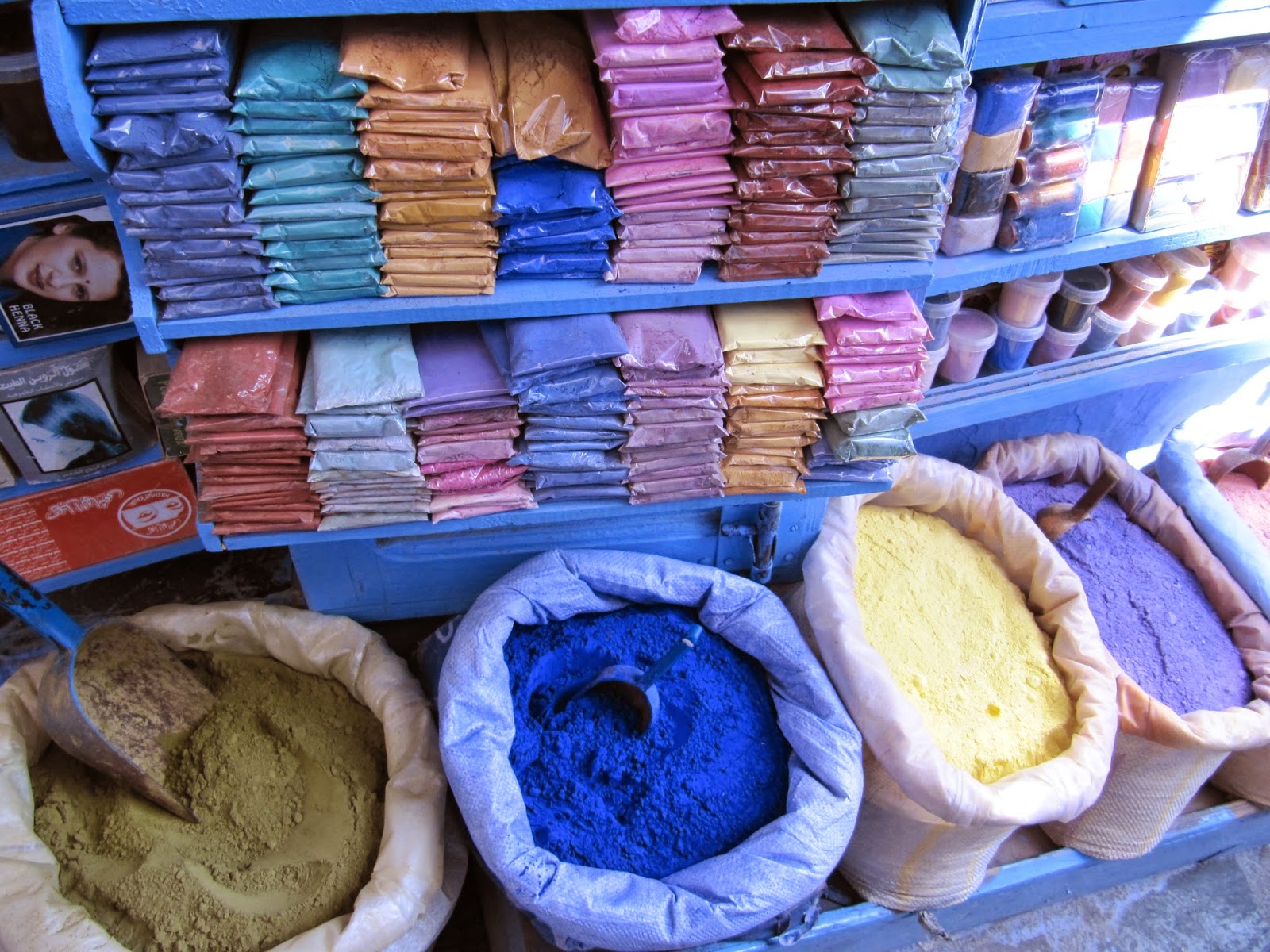

More lamps. We were sorely tempted to buy, but did not succumb.
If you can imagine, these are steps leading into and out of a shop. So beautiful, but so dangerous. I wonder how many people fall down them.
We reluctantly left Chefchaouen. Even though we had been there only a few hours, we had all fallen in love with it. On our way to that night's destination, Asilah, we by-passed storied Tangiers, as do most of the tours to Morocco.
Asilah to El Jadida, by way of Rabat, the capital

As we made our way down the coastal highway, we also by-passed Casablanca, another famous city that most tours steer clear of, but did stop in Rabat/Sale, the Buda and Pest of Morocco.
As we followed these winding streets from where we parked the van to get to the sea, I was enchanted by the colors and shadows. In all of these photos. we are within the 11th century fortress walls of the Casbah of the Oudayas. You will notice how different the architecture is here -- it's Andalusian style -- from that within the medinas in Marrakech and Fez.
Some young jewelry makers/sellers were just setting up their wares in front of a very interesting mural.
And finally we got to the sea.
Several hours later, we were on another body of water, the Bou Regreg River, which divides Rabat from Sale.
Parents could rent these little cars for their kids.
The detailing was quite exquisite.
Or perhaps a kite.

The Casbah of the Oudayas.
A more recent photo of the royal family. The king is dedicated to keeping fundamentalism out of Morocco. To that end, only pre-recorded prayer calls can be broadcast from the loudspeakers of mosques to prevent radicals from voicing their views. Demonstrations are permitted on Sundays. He has made many reforms to the status of women. He and his family live in Sale in a modest flat, and the king drives himself to "work." His motto is "modest and modern." He is very, very popular.
One of the guards outside of the main historical and tourist complex of Rabat, Morocco's capital city, and yet another imperial city, which contains the Hassan Tower and the mausoleum of the first king of independent Morocco, Mohammed V, the current king's grandfather, Hassan II, his father, and his father's brother.
The mausoleum.


One of the guards must have been flirting with me, as he asked me to go into a roped-off area and said he would take photos of me. That was all well and good until another guard came over, reprimanded him, and made him give me back my camera. Not bad pictures, though.
Right across from the mausoleum was the Tower of Hassan, the minaret of an incomplete mosque, which was started in 1195, and intended to be the largest minaret and mosque in the world. When the sultan building the mosque died in 1199, construction stopped at about half of the intended height of the minaret. The mosque's hall, held up by pillars, was used until the Great Earthquake of 1755, which brought down its central columns. It was never rebuilt, but some of the columns have been partially restored to offer some sense of the building's size and intended layout. Our guide told us that the tower used to be open to tourists, but because of a rash of suicides, it has since been closed.

I was charmed by this road sign that our guide pointed out.
And you can certainly guess that this is a stop sign by its iconic shape.
We went to a really cool place for lunch. At the entrance to the restaurant, we were poured warm water to wash our hands.
And of course our tea was poured in a highly dramatic way, made even more theatrical by the height of our waiter.
We continued our drive down the coast to El Jadida, where we spent the night.
Our Next-to-Last Stop, Essaouira
The following morning, we were off to Essaouira, also on the Atlantic Ocean. Essa, as it is called there, is a delightful treat in every way. Aside from relaxing, enjoying the sea air, and just "being," there isn't much to do there. Sleepy, unspoiled, and charming, Essaouira was the perfect place for us to wind down after hectic weeks of travel. Compared to shopping in Marrakech and Fez, shopping in Essa is an easy, laidback experience, rather like Chefchaouen. Prices here are a fraction of those in other parts of the country. (From Vicki's materials.) Vicki had told us this at the start of the tour, but none of us could wait and did much shopping everywhere we went. However, that didn't stop us from shopping here, too.

Essa is a 17th-century Portuguese-style blue and white coastal town, popular with Orson Wells, Jimi Hendrix, the Beatles and others. The fortified city walls house what once was a pirate community. Even the Phoenicians once settled here, having found a local source for the mollusks that provided their much-loved purple dye. (From Vicki's materials.)
At the seaside, we saw many fishing boats (the fresh seafood is known to be the best in all of Morocco), and the more adventuresome of us sampled some raw oysters and razor clams - fresh from the sea, skillfully opened, and squirted with lemon juice. I was not among the takers.
Of course our Carolina -- first on the camels, remember? -- was the first to try the delicacy.
And then Vicki.
This vendor was offering sea urchins. No one tried those.
We felt very secure in eating this seafood as all of the vendors were licensed, and certainly couldn't have been any closer to the ocean!
Of many, many highlights on this trip, the visit to Marjana, the women-owned cooperative for the extraction of argan oil from the kernels found inside the fruits of the argan tree, grown only in Morocco, was probably my favorite. It is one of the rarest oils in the world due to the small and very specific growing areas. I thought I'd copy what Wikipedia said about it:
"The fruits of the argan tree are nut-sized and may be round, oval, or conical in shape. The fruits have a thick peel which covers the fleshy pulp. The pulp surrounds a hard-shelled nut which represents approximately 25% of the weight of the fresh fruit. Contained within the nuts are one to three argan oil-rich kernels. Argan oil is extracted from the kernels, with yields varying from 30% to 55%, depending on the extraction method used.
Extraction of the kernels is key to the argan oil production process. In order to extract the kernels, the fruits are first dried in the open air and then the fleshy pulp of the fruit is removed, sometimes mechanically, without the need to dry the fruits. The flesh is usually used as feed for animals. The next stage involves cracking the argan nut to obtain the kernels.
Attempts to mechanize this process have been unsuccessful and therefore it is still carried out by hand, making it a time-consuming and labor-intensive process (reflected in the sales price of the oil!). Berber women, whose skills are unparalleled, often engage in this arduous process of retrieving the kernels.
Kernels used to make culinary-grade argan oil are then gently roasted. After the kernels have cooled down, they are ground and pressed. The brown-colored mash expels pure, unfiltered argan oil.
After pressing, the oil is decanted and left to rest for approximately two weeks, during which time the solids suspended in the oil settle to the bottom, creating a natural sediment. The clear oil may then be further filtered depending on the clarity and degree of purity required. The protein-rich press cake remaining after the oil has been expelled is frequently fed to cattle. Nothing is wasted!
A heart-healthy gourmet product, argan oil can be used to dip bread in or to drizzle over couscous or salads. When not roasted -- to avoid an excessively nutty scent -- it is an ingredient in high-end personal care products."
Twenty-five to 30 kilos of argan nuts produce 2 kilos of kernels, which produce one liter of oil.

When we entered the workshop, there was a huge amount of noise: women laughing, singing, and ululating (trilling with their tongues). We just had to smile. They were so welcoming, and, unlike the women in the rose workshop, these women were not averse to having their photos taken.



Our very-pregnant guide walked us through the entire process.
Here is a bowl of the argan fruits.

I believe that the nuts of the argan fruits were removed elsewhere. This place seemed to be working just with the nuts and the kernels, not the fruits. These highly-skilled women are cracking the nuts with a smaller stone on top of another larger one, with the nut in between, to free up the almond-shaped kernel(s) inside.


What an incredibly tedious process. I asked the guide if they switched jobs around periodically, and they do.

The finished product after that intensive labor -- the argan kernel.

The extracted kernels are then hand pressed to remove their oil.


The remaining "stuff" from the press is squeezed even more to extract more oil.

These "cakes" of the remains of the kernels after their oil is extracted are fed to livestock.

Then our guide led us to the showroom, where we were offered the ever-present mint tea and were invited to take a piece of bread and dip it into a small container of argan oil used for cooking. It had a brilliant, delicious toasted nut flavor.



And then the buying began. It was difficult to select products, as there were so many, but there were helpful saleswomen to assist. I am sure that they were VERY happy with the number of products our group of six women bought!
Music and musicians are plentiful in Essa, and a hippie environment still stamps the atmosphere with a careless, joyful ease. We had a fun dinner at a popular restaurant with a great, young band.
Vicki ordered crepes suzette for dessert. Don't know if you can see the small blaze rising from the ladle, but it's there.
Loved the repurposing of old jeans.
Check out the elaborate head coverings of the men there, so different from other places we'd been.
Then we went to check out the ramparts. Well, I've heard about ramparts from the Star Spangled Banner, but I guess I didn't actually know what they were. I do now.
Essa is known for its wooden handicrafts made of thuja wood from the root (a piece of which is to the left of center in front of the display in this photo). I bought a number of fine products there as gifts.
Another of Vicki's vendor friends, Othman, from previous tours. This handsome, personable young man, who is from the same desert tribe as Ali, our guide, knits wool caps while waiting for customers.
I bought one for my son (who loves it!) and asked Othman to model it in the two ways it could be worn, so I could show him.
By this point in the trip, I was sorely in need of a haircut, and I was tempted to try this shop, but I didn't.
Back to Marrakech and Departure
We drove back to Marrakech, which was not such a long drive. We spent the rest of the day racing around doing last-minute shopping, and packing for our flights the next day. We stayed at the same riad we were in at the beginning of the trip, so we were re-united with the things we'd left there for safe-keeping and so as not to have to schlep them around with us. We settled our bill with our lovely inn-keeper, who has become a dear friend of Vicki's. That night, our last meal together, which was in the modern part of town at the restaurant Al-Fassia, run exclusively by women, was beyond incredible. First we shared all of these small plates,
and then we moved on to tajines!
Vicki had arranged transportation for us to the airport (three different leavings just as there had been three different arrivals), and Jude and I were first off. We had decided months earlier to fly to Paris and over-night there to break up the trip before returning to our separate destinations in the States. It was a wise decision, although I had bought entirely too many things, wound up with my original suitcase and carry-on, a duffel bag I borrowed from Jude, and a backpack, paid dearly for the extra luggage, and had to get them to the Paris hotel and back to the airport the next morning, from JFK airport into NYC and then onto the bus to Philadelphia, and then into a taxi to my apartment. But I'll probably never return to Morocco, and I wanted to give everyone I loved a little piece of it.
I actually cannot imagine taking this trip with anyone but Vicki. Her deep love for the country, the people and their customs, and the food shown through everything we did. She had boundless energy, and was perpetually cheerful and unflappable, as was Ali, our Moroccan guide. I always felt safe, well-taken care of, and certainly well fed. If you are interested in taking this trip, contact Vicki Challancin at flavorsofthesun@yahoo.com. You can also read Vicki's blog at http://flavorsofthesun.blogspot.com, which often includes recipes as Vicki runs a cooking school in San Miguel.
Now, five months after the trip's conclusion, it feels like a dream, but one I'm so glad I had. Thank you, Vicki!

























































